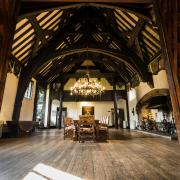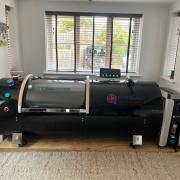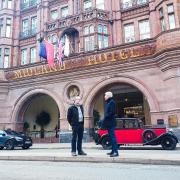When in 2015 Her Majesty The Queen opened a new visitor centre commemorating the bravery and sacrifice of the men who won the Battle of Britain in 1940, she met some of those who had helped defend this country against invasion.
Among them was the tall, distinguished figure of Bootle-born Tom Neil, then 94 and one of the most successful airmen during the air battle that was to change the course of history.
Wing Commander Neil, born on July 14 1920, flew Hurricanes with No 249 Squadron throughout the Battle of Britain and achieved ‘Ace’ status – awarded for destroying at least five enemy aircraft in the air.
In Neil’s case he didn’t stop at Ace. A pre-war member of the Royal Air Force Volunteer Reserve (RAFVR), he is credited with having destroyed more than 17 enemy aircraft, most of them during the battle that forced Hitler to cancel his invasion plans and arguably hastened the end of the Second World War.

On just one day, September 15, now commemorated as Battle of Britain Day, he is recorded in the definitive reference work Men of the Battle of Britain as having destroyed two Messerschmitt Bf109s and one Dornier Do17 and having shared in the destruction of another Do17, as well as being credited with a ‘probable’ Heinkel He111. He was awarded the DFC on August 8, in the midst of the battle, and received a bar to that decoration just six weeks or so later.
Tom Neil went on to see further action in Malta – regarded by many as a fiercer conflict than the Battle of Britain – with No 249 Squadron. In 1944, while attached to the American 9th Air Force, Wing Cdr Neil took part in the invasion of Normandy and remained with the USAAF until the Allies reached the German border.
The D-Day landings on the Normandy coast bring home the importance of what Churchill’s ‘Few’ did in 1940, keeping this country free from invasion so the south coast could be used as a springboard for the retaking of mainland Europe four years later.

The ‘immediate’ award of the Battle of Britain Clasp to the 1939-45 Star was only made to aircrew who had flown at least one operational sortie with a recognised squadron or unit of Fighter Command between July 10 and 31 October 31, 1940.
As wartime Prime Minister Winston Churchill famously said: ‘Never in the field of human conflict was so much owed by so many to so few.’
The Few have inevitably become fewer over the years. At the time of writing there is thought to be one still alive, 103 year-old Group Captain John Hemingway, who lives in a nursing home in Dublin.
Serious scholars will not risk putting an accurate figure on the number of the Few, record-keeping being a somewhat less exact affair on squadrons that were having their runways bombed day after day than it is now, but it is certainly true that fewer than 3,000 men came to the rescue of the free world that summer.

A figure of around “2,940-something” is all that the Battle of Britain Memorial Trust, caretakers of the National Memorial to the Few at Capel-le-Ferne, near Folkestone in Kent, will confirm.
Whatever the exact figure, the names of all those who took part (accurate at the time it was commissioned) are carved on the black granite of the Christopher Foxley-Norris Memorial Wall, to the rear of this tranquil and moving site.
Wing Cdr Neil, who died on the evening of July 11 2018, just three days before his 98th birthday, served alongside a number of other aircrew – the Trust never refers to ‘pilots’ as it excludes the air gunners and radar and wireless operators who served in two-seater aircraft – who hailed from Lancashire.
They include Edmund Walsh, who was born in Manchester in August 1918, joined the RAFVR in 1939 and trained as a gunner in time to serve in the Battle of Britain. He flew with No 141 Squadron, firstly in Defiants and, after August 1941, in Beaufighters.
After qualifying as a radio observer, Walsh returned to 141 and resumed operational flying with Warrant Officer RC Hamer. Walsh was commissioned from Warrant Officer in August 1942.
In the early hours of September 9 1942, Hamer and Walsh attacked an HE 111. The enemy aircraft was destroyed but Hamer was wounded and the Beaufighter’s starboard engine set alight. Hamer flew the aircraft back over the Isle of Wight and ordered Walsh to bale out before flying to his death. They had flown together 219 times.
Sergeant James Alan Buck was born in Chorltonville, Manchester in 1916. A pre-war member of the RAFVR, ‘Jimmy’ Buck’s operational career, as a Hawker Hurricane pilot with No 43 Squadron, was brief.
He joined the Squadron in February 1940 and saw action during the Battle of France before moving with 43 to Tangmere, Sussex in July 19, just nine days into the Battle of Britain. Over the sea off Selsey, after combat with German fighters, Jimmy Buck baled out, wounded. British air sea rescue facilities were primitive at the time, and he drowned. He is buried in Stretford cemetery.

Peter Malam Brothers, born in Prestwich in 1917, was a small man who made a major impact during the battle as a senior pilot on two Hurricane squadrons, being credited with 12 victories during that conflict.
Brothers learned to fly at 16, was commissioned in the RAF at the age of 18 and, when the Second World War began, he quickly ran up a significant score of German aircraft. He was awarded the DFC on September 13 1940 and received a Bar to that decoration in 1943.
Later in the war Pete Brothers had the prestigious job of leading the Tangmere Wing of fighters. In 1965 he was one of the Few who took part in Sir Winston Churchill's funeral procession, and he didn’t retire from the RAF until 1973 – as an Air Commodore. He was chairman of the BBFA from 2003 until his death on December 18 2008.
The National Memorial to the Few at Capel-le-Ferne, an enigmatic statue of a seated airman staring out across the Channel towards the coast of France, was unveiled in 1993 by Her Majesty Queen Elizabeth the Queen Mother and celebrates its 30th anniversary this summer.
The simple central memorial, set at the centre of a white brick propeller design that is particularly striking from the air, has since been joined, not just by the Memorial Wall but by full-size replicas of a Hurricane and Spitfire, the two best-known fighters of the period.
In 2015, following a £3.5m fund-raising appeal, the Battle of Britain Memorial Trust invited Her Majesty The Queen and HRH The Duke of Edinburgh to unveil The Wing, a modern visitor centre built in the shape of a Spitfire wing. The building includes the high-tech, audio-visual Scramble Experience, a shop and education centre and first floor café with views of France on a clear day.
battleofbritainmemorial.org




























